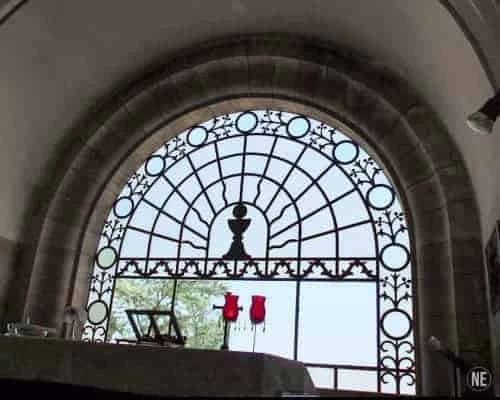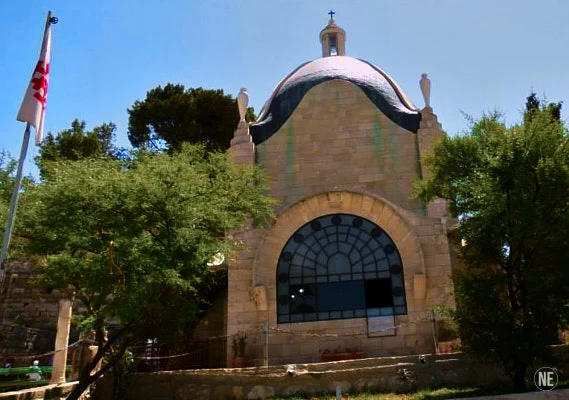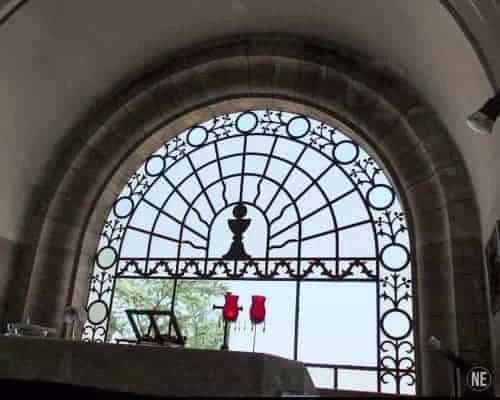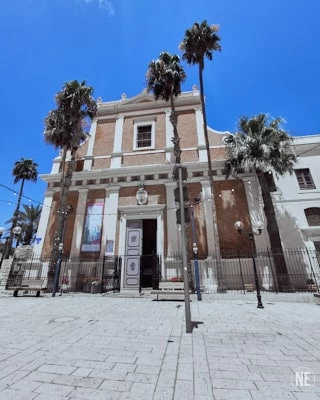The church, known in Latin as “Dominus Flevit,” translates to “The Lord Wept.” Situated on Mount Olive in Jerusalem, it holds profound symbolism as the place where Jesus, riding on a donkey, wept while overlooking the city on Palm Sunday. This poignant moment is recounted in the Gospel of Luke (19:41-44), where Jesus mourns over Jerusalem’s fate, foreseeing the impending destruction of the Jewish Second Temple and the city itself.
As Jesus approached Jerusalem, he beheld the city and lamented, expressing his sorrow that its inhabitants failed to recognize the path to peace that he embodied. He prophesied the coming calamity, forewarning of a brutal siege and the devastation that would occur in Jerusalem. This tragedy, he declared, would be a consequence of their inability to discern the significance of his arrival as the Son of God.
The church of Dominus Flevit serves as a poignant reminder of this sad moment in Jesus’ journey, inviting reflection on the consequences of rejecting divine guidance and the profound compassion of the Lord.

Basic Details of Dominus Flevit
Church name: Dominos Flevit
Christianity order: Catholic Roman Church (Franciscan)
Year of construction: 1955
Address: Mount Olive, Jerusalem
Opening hours:
In the Summer, 8:00-12:00 am, 2:00-6:00 Pm
In the Winter, 08:00-12:00 am, 2:00-5:00 pm
Phone: +972-(0)2-6266450
Map:
Building History
The church was designed by the renowned Catholic Italian architect, Antonio Barluzzi, who is celebrated for his architectural contributions to numerous churches in Israel. Established in 1955, the building’s design intricately reflects the prophesied destruction foretold by Jesus. The church itself is shaped like a teardrop, symbolizing the sorrow and mourning expressed by Jesus over the fate of Jerusalem.
This motif is further emphasized by four stone statues adorning the corners of the building, each depicting bottles or vials symbolizing tears. In ancient Roman tradition, mourners would collect their tears in small glass vials, which were then buried alongside the deceased. This poignant imagery evokes the profound grief and lamentation of Jesus’ prophecy.
Additionally, within the chapel’s eastern section, visitors can marvel at the remnants of a mosaic dating back to the Byzantine period, believed to originate from the 7th century. This ancient artifact connects to the region’s rich history and adds historical depth to the site’s spiritual significance.

Interesting design detail in this church
Since the fourth century, churches have typically been constructed with the altar facing east. However, Barluzzi’s design diverges from this tradition by placing the altar in the west. This deliberate deviation makes the church a rarity in Israel and globally, as it does not conform to the customary east-facing orientation.
The decision to position the altar facing west holds profound symbolic significance. By facing Jerusalem, the city foretold by Jesus to face destruction, Barluzzi contemplates the landscape beyond the altar. Through the window, visitors are confronted with the stark reality of Jesus’ prophecy: the absence of the Temple, which would have stood before them had the prophecy not been fulfilled.
Adorning the window are intricate decorations, including a depiction of the crown of thorns, a goblet of wine with communion bread, and a cross. Many visitors are drawn to photograph the cross juxtaposed against the iconic Dome of the Rock, creating a powerful visual representation of faith and history. Interestingly, when viewed from beneath the center of the dome, the cross aligns with the Church of the Holy Sepulcher, further intertwining the church’s symbolism with Jerusalem’s sacred landmarks.
Additionally, reliefs on either side of the dome offer poignant representations of biblical events. On the western side, Jesus is depicted riding a donkey, evoking his sorrowful journey towards Jerusalem. Conversely, on the eastern side, Roman soldiers ascend the walls of Jerusalem, symbolizing the fulfillment of Jesus’ prophecy of destruction. These reliefs serve as poignant reminders of the sacred narrative embodied by the church’s architecture.
| Bus lines | You should drive No.1 to Mount Olive Observatory and write in your waze, “Olive Mountain.” |
| Car | You should drive No.1 to Mount Olive Observatory and write in your waze, “Olive Mountain.” |
| Taxi | You should drive No.1 to Mount Olive Observatory and write in your waze, “Olive Mountain.” |
Upon reaching the Mount of Olives Observatory, take a leisurely stroll down the historic path where Jesus rode on Palm Sunday, seated upon a donkey. As you descend from the mountain’s summit, you’ll traverse a remarkable route that bears witness to centuries of pilgrimage and sacred tradition.
Along the way, you’ll encounter the world’s most ancient graveyard, steeped in history and reverence. Keep an eye out for the Franciscan “Jerusalem Cross” sign on your right, marking the entrance to the Dominus Flevit church. Here, at the entrance to the compound, you’ll find a covered area sheltering an exposed cemetery featuring a Jewish necropolis with approximately 150 distinct tombs.
This unique blend of sacred spaces reflects the rich tapestry of religious heritage and historical significance that characterizes the Mount of Olives, inviting visitors to pause, reflect, and contemplate the enduring legacy of faith and spirituality that permeates this sacred site.
Accessibility
for handicap can park at the entrance to the church, but there is limited space, please coordinate with the church.
Public Toilet
There are public toilets available.
Near site activities
Continuing along the trail, you’ll soon encounter the Churches of Mount Olive, each with unique charm and significance. Among these notable landmarks are the Russian Orthodox Mary Magdalene Church and the Church of All Nations.
As you approach these sacred sites, take in the serene surroundings and marvel at the architectural splendor that graces the landscape. Don’t miss the opportunity to capture the breathtaking panoramic views of the Temple Mount from the churchyards. With its timeless beauty and historical resonance, this vantage point offers a photographic landscape that captures the essence of Jerusalem’s spiritual and cultural heritage.
My experience
This church is a milestone for every pilgrim to the Holy Land. It is small and intimate, allowing you to identify with the story that took place here. When you walk through the pastoral courtyard and see the impressive church building in front of the old city, you cannot ignore that the place evokes emotions.
Is it possible to book a holy mass here through the Christian Office or ask us for assistance? https://www.cicts.org/en
The colorful Byzantine mosaic floor enhances the experience of the place. The location of the altar and the window overlooking the old city causes the church to tell the story in an original way, against the traditional architectural laws in the churches where the altar faces east. It is a charming, pastoral place and a must for every visitor to Jerusalem.
The Franciscan cross symbol story
As you pass through the gate to the church, you’ll be greeted by a distinctive symbol that holds deep significance for the Roman Catholic Franciscan community. This symbol, prominently displayed with a large cross at its center and four smaller crosses surrounding it, is known as the Jerusalem Cross.
Legend has it that Father Francis of Assisi, a revered figure in the Catholic tradition, experienced a vision in which he beheld the wounds of Christ imprinted upon his own body. These wounds mirrored those inflicted upon Jesus during his crucifixion, including two on the hands, two on the legs, and a larger wound in the center of the body, symbolic of the spear thrust inflicted by the Roman soldier.
Inspired by this vision, the five crosses symbolized the Roman Catholic Church’s enduring connection to Jerusalem and the profound spiritual significance of Christ’s sacrifice. Today, the Jerusalem Cross is a potent reminder of faith, redemption, and the enduring legacy of Christ’s love and sacrifice.




